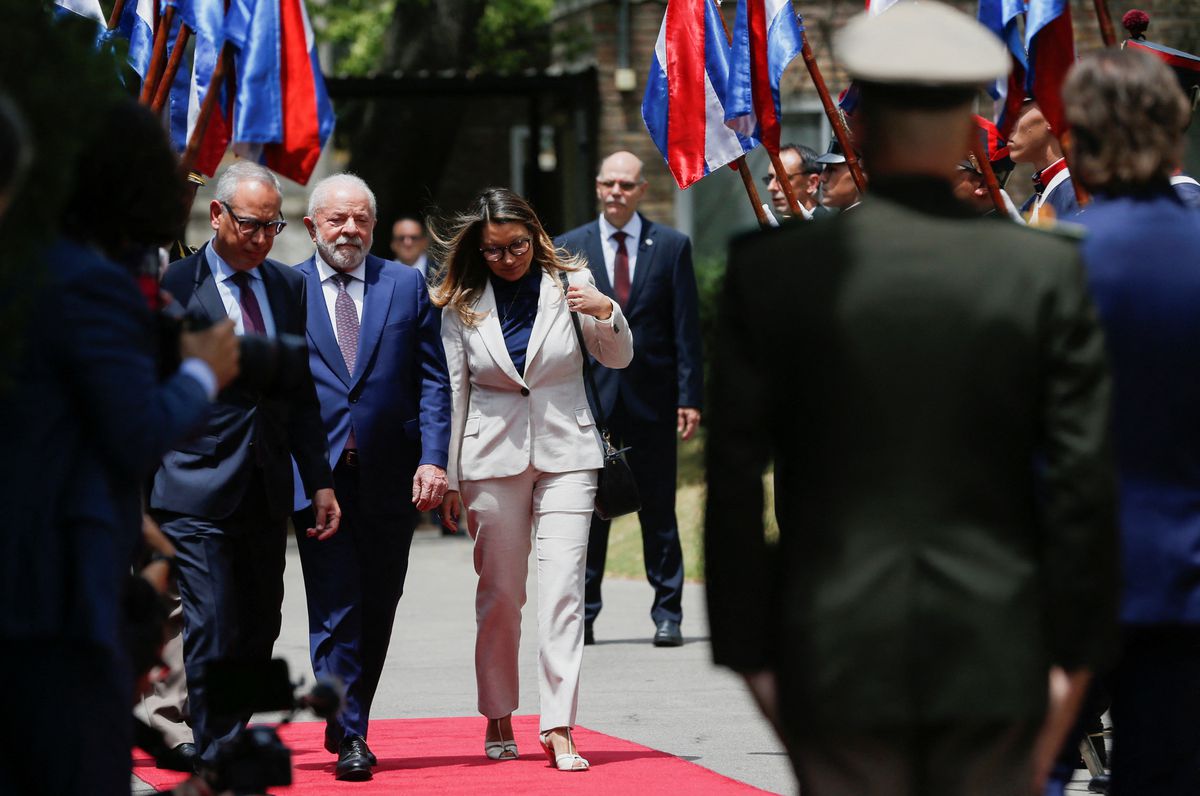 Brazil’s President Luiz Inácio Lula da Silva and his wife, Brazil’s First Lady Rosangela “Janja” da Silva, walk at the Suarez residence in Montevideo, Uruguay January 25, 2023. MARIANA GREIF (Portal)
Brazil’s President Luiz Inácio Lula da Silva and his wife, Brazil’s First Lady Rosangela “Janja” da Silva, walk at the Suarez residence in Montevideo, Uruguay January 25, 2023. MARIANA GREIF (Portal)
If only Latin America had an economic union as strong as that of Europe, it would be a world power. At least that’s an argument often heard in multilateral fora and one that politicians like. The announcement of a potential shared currency between Brazil and Argentina, rather than a real possibility, has been widely interpreted as the latest message in favor of Latin American integration. But it’s not the first. History is littered with attempts to boost the economy through unions, some unsuccessful, some successful.
The idea was revived with the return of Brazilian President Luiz Inácio Lula da Silva, says Argentinian Carlos Malamud, historian of Latin America and author of Bolívar’s Dream and Bolivarian Manipulation: Falsification of History and Integration in America Latina (Alliance, 2021). The re-election of Lula, as the left-wing leader is colloquially known, comes at a time when the five largest economies (Brazil, Mexico, Argentina, Chile, Colombia and Peru) have left-wing governments, so there is potential for better coordination.
“An excess of rhetoric, an excess of nationalism and a lack of leadership” have historically been the greatest obstacles to integration, stresses Malamud. “This coin project basically fits into this excess of rhetoric. More than the announcement itself, I was struck by the echo of the press, with headlines that assumed that this would happen,” said the specialist.
Malamud recalls efforts to create the Bank of the South around the turn of the century, which then-Venezuelan President Hugo Chávez took the lead in 2007. The idea was not only to replace the International Monetary Fund (IMF) as lender, but also to eventually create a common currency between Argentina, Brazil, Bolivia, Ecuador, Paraguay, Venezuela and Uruguay. Ecuador wanted to call it Sucre, Bolivia Pachamama, Malamud recalls.
“It ended in failure, just as the Bank of the South failed,” says the academic, who is also a researcher at the Elcano Royal Institute. The Andean Community (CAN) and the Latin American Integration Association (ALADI) were formed to promote intra-regional trade, which today accounts for only 16% of all trade in Latin America. Other efforts have stayed with relatively good results over time. The Central American Common Market (MCCA) made some strides in terms of electrical infrastructure, while for years the Southern Common Market (Mercosur) represented a real way to increase trade between countries. Today, Mercosur is experiencing moments of political division.
A report by the CAF-Development Bank of Latin America released last year shows that with the Free Trade Agreement with the United States and Canada (TMEC), Mexico increased its foreign trade by more than 50 points of gross domestic product (GDP) between 1980 and 2019. During Central America and the rest of Latin America saw moderate increases from 58% to 72% of GDP and from 52% to 62% respectively over the same period.
Late last year and before Lula took office, left-wing governments in Latin America showed their division and disunity when the Inter-American Development Bank (IDB) sought a new president. Brazil, Chile, Mexico and Argentina each proposed a candidate, narrowing down the possibilities for consensus and revealing the rifts between them.
One of the “founding myths” was the idea of interventionism, says Malamud. “This idea that we’re not integrating because the United States won’t let us is closely related to the weight that nationalism carries in the region. A nationalism that has a very strong anti-imperialist, anti-American component,” says the historian. In reality, what historically prevented integration was a lack of leadership and a lack of political will to look beyond what is happening in each country, argues Malamud.
According to an IDB study published last year, seven out of ten Latin Americans support greater integration of their country with other countries in Latin America and the Caribbean. This sentiment in favor of economic integration is more pronounced among the youngest (16 to 25 years old). More than half of Latin Americans welcome trade deals between their country and others in the region.
“The clear support of the citizens of Latin America and the Caribbean for regional integration, free trade and trade agreements is a key factor that countries must use to design and implement strategies that promote inclusive and sustainable growth in our region,” said Fabrizio Opertti, one of the report’s authors, according to an IDB statement. 70% of Latin Americans are committed to free trade.
Perhaps that is why one of the most successful efforts to integrate economies has been the most recent. “The big surprise of the last decade was the Pacific Alliance,” composed of Chile, Colombia, Mexico and Peru, Malamud said, “which represented a very important paradigm shift at the time.”
With the arrival of Chávez and his ideological allies, trade was demonized to promote political rather than economic and commercial integration, the expert explains. “And if the Pacific Alliance is formed, it somehow goes beyond that level and raises important issues at the time, like the centrality of trade, like the role of private initiative in economic integration, something that concerns the statism of the Bolivarian and related governments rejected,” says Malamud.
The scientist hopes that the announcement of the Brazilian-Argentine currency will be quietly forgotten. Argentina would have much more to gain from a project like this as it suffers from an inflationary crisis. “The question is, why did Lula say yes? Knowing Lula’s character, he usually doesn’t openly say no. He will look for a way to derail the project, stop it, make it disappear and eventually disband,” says the historian.
THE LAND of the morning
Wake up to Berna González Harbor’s analysis of the day
GET IT
Subscribe to continue reading
Read without limits

